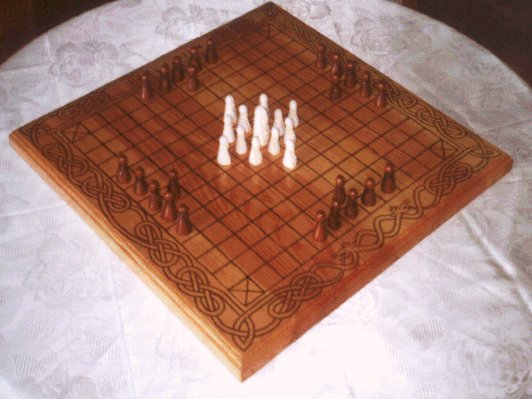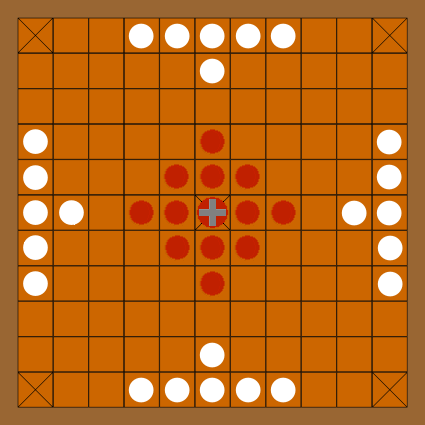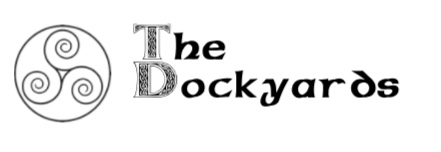The Early Medieval Chess Of The Norsemen – Hnefatafl
The Hnefatafl (alternatively known as King’s board or tablut) was a strategy board game similar to contemporary Chess that was invented and played by the Norsemen in the time of the Viking Age. From native Scandinavia, the Norsemen brought the hnefatafl to their overseas colonies, most notably in the North Atlantic ones (i.e. the Faroe Islands, Iceland, and Greenland) but also in modern day Ireland, Scotland, and England. Similar games also existed in the Celtic-speaking world prior to the apparition of the hnefatafl.

Reconstructed Hnefatafl game pieces. Image source: www.imgur.com
This game enjoyed considerable notoriety during the Viking Age, an era often dominated by both internal or external military conflicts and turmoil in Scandinavia and overseas. It should be mentioned that the game was brought to Garðaríki (modern day Russia) as well.
The name of the game can be translated from Old Norse (via modern Icelandic) as ‘fist table’, with ‘hnef’ meaning ‘fist’ and ‘tafl’ meaning ‘board’ or ‘table’. Alternatively, it is also known as ‘King’s Table’. In medieval times, it was mentioned in such sagas as those of Frithiof’s, the Earls of Orkney, and of Hervör and Heidrek.
Nowadays, the basic rules of this medieval strategic game are rather obscure. Even though the Icelandic sagas mention the fact that the Norsemen were quite keen on playing strategy games such as hnefatafl, these sources lack sufficient documentation with respect to the rules of the respective game. Yet, some of the sagas ascribe the possibility of throwing the dice.
What remains known, however, is that two prospective players would engage in a test of intelligence, skill, and strategy similar to that of the contemporary chess. One player would start the game with more pieces than the other in order to conquer the king’s castle (with the king being placed in the very centre of the board). The other player who had the king on his behalf would have a significantly reduced number of pieces. Each player controls a set of pieces (marked/known as brown or attackers versus white or defenders) and the ultimate goal of the game is to subdue/conquer/defeat the opponent. As the player with the brown pieces, one has to take down the king and capture as many of his soldiers in the process as well. As white, the player must escape by managing to move the king on either sides of the board (namely to one of the four X-marked corners, see below). Players can only move their pieces orthogonally (that is, either up and down or left or right).

Hnefatafl (or tablut or King’s board) board with both white and brown pieces and a traditional Viking/Scandinavian art motif on its sides. Image source: Wikimedia Commons
From archaeological research, it results that the game must have been played on either 13×13 or 11×11 boards. It is known that it became obsolete after the 12th century, when chess has been already introduced to Scandinavia.

Probable 11×11 Hnefatafl board game. Image source: Wikimedia Commons
It is equally important to note that, among the grave offerings unearthed through extensive archaeological discoveries in the passing of time, such recreational games as hnefatafl were also given to the defunct Norsemen for their other world journey. Nowadays, if you are interested in this game, you can play it digitally via Steam here.
Documentation sources and external links:
- Tafl games on www.wikipedia.org (in English)
- Celtic and Old Norse boardgames vs the omnipresent Chess on www.medievalboardgames.wordpress.com
- Has Hnefatafl been introduced in Ireland? on www.medievalboardgames.wordpress.com
- Vikings Were Buried With Board Games For Recreational ‘Diversion’ In The Afterlife on www.realmofhistory.com
- Vikings were buried with board games to beat boredom on www.scotsman.com
- What did Vikings do to entertain themselves? Play Hnefatafl on www.spangenhelm.com
- Viking Games and Entertainment: Life Wasn’t all Work on www.historyonthenet.com
- Hnefatafl on www.wikipedia.org (in Norwegian Bokmål; an article to which I modestly/partly contributed in the past as well)


great article , this book is unquestionably one in all the simplest for young chess players to scan and learn strategy terribly useful
Hello and thank you very much for your supportive comment! I truly appreciate it and I am grateful for your kind words! You have a great website on Hnefatafl as well! Keep up the good work and all the best! Last but not least, thank you for your time and readership here on The Dockyards! Have an excellent day!